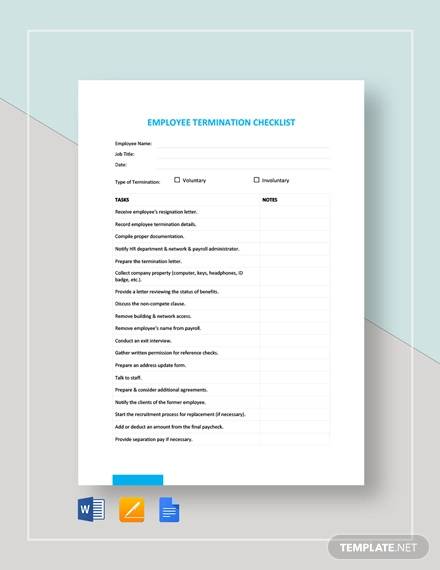In the workforce, there are good and bad employees. If you are an employer or a manager of a company, it is important that you have the skills and the talent to be able to tell which employee is good and which employee is bad. And we’re not just referring to employees with good and bad attitudes, we mean employees who are good for the business and employees who are bad for the business. You can also like audit checklist templates.
In order to do this, managers need to be keen and observant so that they would know which employee is just pretending to be good for the business and which employee needs to go. Of course, everybody wants to look good in front of their employers or managers. This is what makes decision-making difficult. So for employers and managers to make the right decisions, they would need a termination checklist.
Employee Termination Checklist Template

Why Do You Need a Checklist to Fire an Employee?
Employers and managers can hire employees who deserve to be in the company and who they think can be an asset to the company. They just don’t decide randomly about it though. Hiring an employee is a process that involves a lot of steps. They make use of a checklist template to be able to cover each step in the hiring process.
Firing an employee is also a process. Employers and managers can’t just fire any employee according to their liking. That is why it is necessary that a checklist should also be used when firing an employee. You can also see monthly checklist samples.
- Every employee is protected by an employment contract and the company’s standard operating procedures. If the employer or manager fires an employee without any justifiable reason, then they may be facing a breach of employment contract or legal matters in court. With the help of a checklist, employers and managers will be reminded of the things and processes that they need to follow when firing an employee. It also reminds them that they just can’t fire employees that they don’t like.
- A checklist for firing an employee can be organized and systematic based on the company’s firing policies and procedures. It can be written in order from the first offense or warning up to the termination part.
- A checklist is useful when firing an employee as it can be used as reference on what violations the employee has committed and what type of warning has been provided to them.
- Using a checklist ensures that employees get a chance to know what they did wrong, for how long the employee warning notices are, when will they refresh, and what they can do to have it lifted. It also lets the employee know what happens if they continue to commit acts that are not good for the company.
How about you? Do you need a checklist? Why? Checklists are very useful and their use is not only limited to firing employees. They can also be used as checklist for harassment investigations, selling a business, and audit checklist.
When Should You Fire an Employee?
There are just and unjust reasons for firing an employee. Sometimes this is because employees have their own definition of just and unjust for the company and employees also have their own understanding of what is just and unjust as employees. You can also see equipment checklist samples.
This is one of the reasons why companies provide employee handbooks so that their employees would comply with what the employer thinks is just for the business and that includes firing employees. Below are the reasons, signs, and instances on when an employer should fire an employee.
- You should fire an employee who is always on the no call/no show list. Absenteeism is critical in a business, especially one that is related to customer service checklist, that is why it is important that an employee give their managers or employers notice that they will not be able to come to work because of this and that. It may be acceptable at first, but if it is habitual, then you might want to be firmer and do what you must or else your business will suffer.
- You should fire an employee when they are not being productive. A company needs to be productive in order to grow as a business. This is made possible by the employees who are working their best and giving their all for the company. But if you have an employee who is not really productive no matter how hard they try, then you must let go of them. It’s for the best. You can also see packing checklist samples.
- You should fire an employee when they are not trying to make improvements. There will always be a rotten crop among your harvest. In a company setting, there will always be an employee who thinks that working too hard is not something that they should do since the other employees are doing it. Now that is not an employee who is worth keeping.
- You should fire an employee if they are argumentative and tend to be unpredictable. Employees who always start an argument with you, their coworkers, and even with the customers is not a good employee. They will only cause trouble and confusion in your business. Let them go before worse gets worst. You can also like inventory checklist samples.
- You should fire an employee who cannot handle and does not want to accept change. Change is the only thing that is constant in life and in business. So if you have an employee who is so reluctant to follow the new changes that the company wants to implement for the best, then it’s time for you to fire them.
- You should fire an employee who does not have what it takes to be part of your company. Being employed and getting to the top requires talent and skills. If your employee does not have what it takes and is not someone who you are looking for as an employee, then you need to reconsider your decision when you hired them. Maybe it’s time that you need to fire them. You can also like meeting checklist samples.
- You should fire an employee who gets a lot of complaints from your customers. Customers don’t just complain because they want to. They complain because there is something wrong. If this employee of yours is getting a wave of complaints from customers, wouldn’t you be suspicious of what they are doing? They could be doing all sorts of things the wrong way.
Can You Fire an Employee without Warning?
Is there really such a thing as getting fired without warning? I mean, wouldn’t you have already known based on your actions and work attitude in a company that you are qualified to get fired any time? Firing an employee without warning does exist and is even being practiced up to this day. It could be just or unjust, and it could be with cause or without cause. Even if this is so, there are still certain instances when firing without warning can be applied legally.
Employees who are hired at-will are prone to getting fired at any time as there are no employment contracts to protect them from such fate. But when you say an employee got fired without warning because of their racial orientation and because the manager doesn’t like them, then that is a different story. Racial discrimination is illegal and so is using it as a reason to fire an employee.
Things That You Should Never Do When Firing an Employee
So you need to fire this employee because they are really not doing or giving any good to the company. You have made up your mind and you don’t want to give them any chances. But wait, aren’t you thinking and acting too rashly? You might be doing things that you shouldn’t do and that might get you into trouble. To avoid getting into serious trouble and before you go fire that employee, you should check out the these things that you should never do when firing them. You can also see delivery checklist samples.
- You should never fire an employee if you have not met them face-to-face. It is just appropriate for an employer or manger to fire an employee face-to-face, not via email or sample letters sent in the mail. You hired them face-to-face, well, you can also fire them the same way. They are humans too, and although getting fired may not always be a rewarding thing, at least it is done personally where the employee can ask the reasons why.
- You should not let an employee bring with them proprietary company information or any company properties when they leave. Everything that the company owns should be returned by the employee to the company. As they are no longer part of the company, they no longer need the things that the company lent them. You can also like inspection checklist samples.
- You should not let the employee feel that your decision to fire them is not final. Be firm when you tell the employee that they are fired, but not in a shouting manner. Do not give them false hopes that when everything is better their termination can be withdrawn and other sorts of reasons. Tell them straight about it.
- You should not fire an employee without giving them any notice. Are employers required to give a layoff notice? Getting fired is bad, but not getting any notice or warning is definitely worse. Your employee will be mad as hell if they find out about it. They would feel blinded and betrayed. The proper way of firing an employee requires that they be given enough warning and coaching before they get fired.
- You should never fire an employee without any witnesses. Sometimes, the employees who get fired feel like they have been betrayed by the company and think that they deserve more. They easily resort to getting a lawyer to sue their employer or manager. Without a witness, the fired employees’ case can be won easily as there are no supporting evidences or witnesses that the employer or company can show. You can also see new hire checklist samples.
We hope that you have learned a lot and are more careful when firing someone. To help you more regarding this, you can check out our Guide to Employee Terminations.
Related Posts
FREE 18+ Complaint Checklist Samples in MS Word | Google Sheets | PDF
FREE 18+ Internship Checklist Samples in MS Word | Google Docs | PDF
FREE 18+ Statement Checklist Samples in MS Word | Google Sheets | PDF
FREE 20+ Voluntary Checklist Samples in MS Word | Google Sheets | PDF
FREE 18+ Summary Checklist Samples in MS Word | Google Sheets | PDF
FREE 14+ Sponsorship Checklist Samples in MS Word | MS Excel | PDF
FREE 18+ Conference Checklist Samples in MS Word | Google Sheets | PDF
FREE 17+ Lesson Checklist Samples in MS Word | Google Sheets | PDF
FREE 18+ Progress Checklist Samples in MS Word | Google Docs | PDF
FREE 18+ Enrollment Checklist Samples in MS Word | Google Docs | PDF
FREE 18+ Graduation Checklist Samples in MS Word | Google Sheets | PDF
FREE 15+ Consent Checklist Samples in MS Word | Google Sheets | PDF
FREE 18+ Review Checklist Samples in MS Word | Apple Pages | PDF
FREE 18+ Submission Checklist Samples in MS Word | Google Docs | PDF
FREE 18+ Request Checklist Samples in MS Word | MS Excel | PDF
